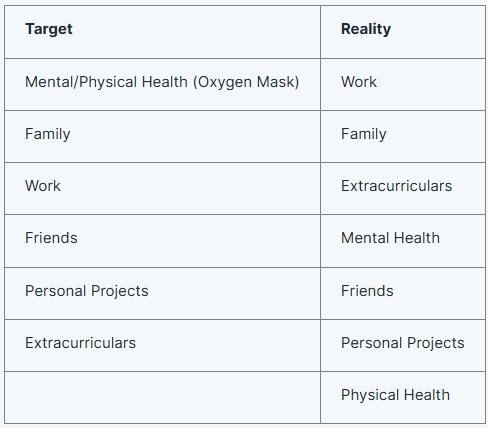Setting Your Priorities (The Bridge)
Part 3 in "Charting Your Path: A Guide to a Meaningful Life"
“Are you living the life you chose? Are you living the life that chose you?” - Jason Isbell
A few years ago, I learned a very important lesson: if you don’t set your own priorities, someone else will set them for you.
In the absence of self-driven priorities, we tend to organize our life based on external forces - bosses, work deadlines, social pressures, or the endless demands of others.
This is great for making other people happy, but it is not very good for making ourselves happy.
To be happy, we must be free to live in accordance with our own sense of purpose and values - something that is not likely to come from a system someone else has set for us.
But living intentionally is hard. We know what’s important, but priorities slip. We react to what’s urgent rather than what’s important. We fail to keep ourselves accountable.
The key is to be explicit about our priorities so we can keep ourselves honest when our actions start to diverge.
Done well, clear priorities make life easier because they reduce the mental friction in evaluating daily tradeoffs. They are the bridge between our purpose (North Star), our values (Compass), and how we make decisions in everyday life.
In this essay, we will walk through how to define your priorities, step-by-step.
1. Identify What Truly Matters
The first step in defining your priorities is identifying the core areas of life that matter most to you.
Common categories might include:
Health & Well-Being
Family & Relationships
Career & Financial Stability
Personal Growth & Learning
Spirituality
Community & Service
This is not about creating a to-do list - it’s about defining what truly deserves your attention.
Ask yourself a simple question: “What are the pillars of a meaningful life for me?”
Write down at least 3-5 broad categories that come to mind.
2. Force-Rank Your Priorities
Once you’ve identified broad categories, you need to rank them in order of importance. This is where many people hesitate - because everything feels important.
A simple three-question test can help:
If I could only make progress in ONE of these areas this year, which would I choose?
Forces clarity on what’s most important right now.
Which area, if neglected, would cause the greatest regret in 10 years?
Helps separate real priorities from temporary distractions.
Which area most enables the others?
Some priorities act as foundational blocks for everything else (e.g., good health supports career, family, and personal growth).
Taking your list from Step 1, force-rank your priorities. It can be helpful to systematically compare one against another to arrive at your rankings.
“Things which matter most must never be at the mercy of things which matter least.” - Goethe
After going through this, you’ll arrive at a force-ranked list based on your current season of life.
Example: A Working Parent’s Priorities
Let’s say someone goes through this process and ends up with:
Family - If they don’t invest here, they’ll regret it most.
Health - Enables them to show up for family and work.
Career - Important, but not at the expense of family/health.
Personal Growth - Still valuable, but secondary.
Community & Service - Matters, but is a lower priority for this season.
This ranking doesn’t mean that lower-priority areas are unimportant - just that they don’t receive as much focus right now.
Priorities shift. A young professional might put career first, while a new parent shifts toward family. The key is to adjust intentionally rather than letting priorities drift unconsciously.
Personal Note: In everyday life, I prioritize my own mental & physical health above all else. This may sound selfish, but it’s based on my belief in the oxygen mask principle: to take care of others, you have to take care of yourself first.
Without good mental & physical health, being there for my family, friends, and colleagues isn’t possible.
3. Evaluate Actual vs. Ideal Priorities
By now, you’ve thought of the areas that matter to you in life, and you’ve ranked them by priority.
This ranking typically reflects what we want our priorities to be, not necessarily what they truly are.
Understanding any gaps that exist between actual vs. ideal priorities is critical to creating alignment with the life you want to live.
Now, let’s take the same group of priorities and rank them once more based on your honest evaluation of how you actually prioritize your time right now.
A useful exercise to help with this can be the “Calendar and Checkbook Test.”
When I look at my calendar over the past 2-4 weeks, where is most of my time and energy going?
When I look at my expenditures, where is most of my money going?
Spot the differences. The end result might look something like the below. This is an actual journal entry of what my priorities looked like a few years ago.
Sometimes it’s hard to be honest about the reality of how you’re living, but this honesty and self-awareness is critical to living a life you are happy with.
In the example above, this forced me to realize that I was not prioritizing my own health, for the sake of work & family, and it was starting to affect me negatively.
4. Recognize That Seasons Change
While this was touched on above, it bears repeating. Priorities are not etched in stone; they change and flow as you move through seasons of life.
The key, again, is to recognize your season of life and adjust priorities intentionally rather than letting someone or something else set them for you.
Examples of how priorities might change:
Early career: Work and learning are often the focal point
Parenting: Family starts to take precedence over solely focused career growth
Later life: Health and service to others may move higher
It’s also worth noting that sometimes life changes priorities for you. If you’ve neglected your health for too long, a heart attack might force you to change your ways. If you’ve prioritized work over family, the risk of divorce might do the same.
The objective is to think about these things intentionally and proactively so we can avoid the adjustments that life makes for us, which are not always kind.
5. Maintain Your Priorities
Once you’ve gone through the process of identifying, ranking, and honestly evaluating your priorities, the last step is to maintain them.
We will dive into this heavily in the next section on Aligning Your Daily Actions, but here are a few quick exercises that can be helpful to keep you on track:
Time Block Priorities: Before the chaos of a given week begins, proactively block off time for your top priorities. For example, I make sure to time block specific periods for exercise during the work week. Otherwise, history has shown that it just will not happen.
Time Audit: periodically, do the Calendar Test. Track where your time actually goes and compare that to your written priorities. This is the easiest way to spot where changes my be needed.
Check-in on Ideal Priorities: While the time audit serves to evaluate your actual priorities, it’s important to check-in from time to time on what your ideal priorities should be. Life changes - perhaps you’ve gotten to a good place at work and now you need to focus more on family or health.
In conclusion, when you actively set and protect your priorities, your path in life becomes clearer and decisions become easier.
Priorities are the bridge between our purpose, values, and the decisions we make in everyday life.
They may constantly evolve, but the key is to keep making the choice in how you live.
In the next essay, we will walk through how to practically apply all of this in a deep dive on time & task management. In aligning our daily actions with our purpose, values, and priorities, we unlock the true key to a meaningful life.
Next Section: Aligning Your Daily Actions (The Journey) - coming soon!





